#Sesame Street Unpaved
Explore tagged Tumblr posts
Text
Muppet Fact #1342
The character of Don Music was retired because of "complaints about his alarming tendencies toward self-inflicted punishment." The character was known for banging his head on his piano when he was frustrated, and apparently, children began imitating this behavior.

Source:
Borgenicht, David. Sesame Street Unpaved. Hyperion Books , 1998.
#muppet facts oc#jim henson#the muppets#muppets#muppet facts#fun facts#sesame street#childrens tv#behind the scenes#don Music#Sesame Street Unpaved#david Borgenicht
244 notes
·
View notes
Text
youtube
We as a society need to start talking about German Rubber Duckie Techno Remix more. The album this is from is soley dedicated to alternate versions of Rubber Duckie in German and sold almost 2 million copies. Oh and it slaps tremendously by the way.
#I've been going insane ever since I've learned of this thing... like seriously#imagine for a moment you're in a german club in the 70s and this absolute bop starts playing. would you be mad?#my source for this is the Sesame Street Unpaved book by the way!#sesame street
5 notes
·
View notes
Note
1-cannot believe it’s taken me this long to find ur blog, muppets AND MCR content are you KIDDING
2- my roommate and I are looking for a Muppets coffee table book of sorts; more about the creation of the characters and Jim Henson’s process and a general background of the show. If you have any recommendations that would be DOPE
oh i have the BEST recommendations for you!!
imagination illustrated is a MUST HAVE imo!!! it was edited by karen falk who is the official archivist for the jim henson company. all the material in this is straight from the jim henson company archives and the jim henson legacy.
jim henson: the works. i dont personally have this one but i've heard good things about it!!! it looks like a fun one to flip through
sesame street unpaved. sesame street specific (duh) but an absolute favorite. behind the scenes photos, scripts, music, stills, etc. theres descriptions of iconic sesame street moments and their making, character profiles, puppeteer highlights, history, etc.
fraggle rock: the ultimate visual history. definitely the priciest one here but if you can afford it it is absolutely worth it. a deep dive into the making of fraggle rock, the show itself, its impact, and and the world of fraggle rock. scripts!! character profiles!! concept drawing!! the pitch document!!!
5 notes
·
View notes
Text





Zoe
PERFORMER Fran Brill 1993-2015
Jennifer Barnhart 2016-present
DEBUT 1993
DESIGN Ed Christie designer
Rollie Krewson builder
Zoe is a three-year-old monster who first appeared on Sesame Street in Season 25.
Zoe was created to help balance what was then a predominately male cast of Muppets on the series. The color orange was chosen for her design to complement Elmo, who was gaining popularity at the time of her introduction.
Apart from some light jewelry, Zoe was originally unclothed. Beginning in season 33, she started wearing a tutu, as — like many girls of her age — she is obsessed with ballet. Her love of dance is featured in several episodes, as well as the home video release Zoe's Dance Moves.
She occasionally rides a soapbox-style car around Sesame Street, called the Zoemobile, and can sometimes be seen with one of two recurring transitional objects: a pet rock named Rocco and a doll named Mimi. She attended the Day Care Center from season 25 to season 29, and generally celebrates her birthday on September 30 (although this date has been inconsistent).
Her Aunt Chloe has been seen on the show, and her daddy has appeared in a few storybooks. Her Aunt Giselle, who lives in Swan Lake, sent her a tutu in season 34.
DEVELOPMENT
From the book Sesame Street Unpaved: "From several possible designs of the character, 'I picked the one that had a face like Carol Channing,' says Fran Brill. 'I wanted her to be obviously female with jewelry and barrettes in her hair. Someone suggested we call her Frannie, since that's my nickname. But I didn't want a Muppet with my name, so I thought of the J.D. Salinger book Franny and Zooey, and suggested Zoe, which seemed to be just right."
To prepare for the character, Brill went to Manhattan preschools and watched 3-year-old girls play. One of the girls said to Brill the phrase which became an early catchphrase for Zoe, "Don't joke me." When the first Zoe puppet was built, Krewson's daughter suggested they put sparkles in her hair.
Beginning with the 2005 Macy's Thanksgiving Day Parade, more hair was added to Zoe, including pink and glittery hairs. In season 40 (2009), a smaller puppet was used, based on the one created specifically for her role as Mousey the Hatter Helper in Abby in Wonderland. This version was only used for one season, and was replaced by the normal-sized Zoe puppet the following season.
At William Paterson University, Martin P. Robinson explained that Telly hadn't appeared in any scenes with the rebuilt Zoe, and Robinson expected that the moment they would meet, Telly would freak out. Fran Brill proceeded to take out the Zoe puppet, and sure enough, Telly freaked out.
↑ hide
NOTES
Before Zoe was regularly seen in her tutu, she wore it on street scenes for Episode 3851 and Episode 3916.
According to the [[Sesame Street Unpaved (book)|Sesame Street Unpaved], her favorite songs are "Let's Go Crazy," "Jump (For My Love)" and "Put on a Happy Face." However, in Episode 4169, her favorite song was Twinkle, Twinkle Little Star.
In the 2008 video Love the Earth!, she was seen as a member of the Bear Scouts.
Zoe got her own bed in Episode 3207.
Zoe learned how to play a trombone in Episode 3994.
Zoe's favorite letter is Z because her name starts with Z.
In Episode 4228, Zoe says she has a brother named Joey.
↑ hide
FILMOGRAPHY
Sesame Street (1993-present)
Sesame Street Stays Up Late (1993)
The Best of Elmo (1994)
Sesame Street's All-Star 25th Birthday: Stars and Street Forever (1994)
Do the Alphabet (1996)
Learning to Share (1996)
Imagine That! (1997)
Elmo Saves Christmas (1996)
Don't Forget to Watch the Movie (1996)
Quiet Time (1997)
Elmopalooza (1998)
A Brief History of Motion Pictures (1998)
The Alphabet Jungle Game (1998)
Elmo's World (1998, 2001, 2005)
The Adventures of Elmo in Grouchland (1999)
Kids' Favorite Songs (1999)
CinderElmo (1999)
Elmo's Musical Adventure: Peter and the Wolf (2001)
Bert and Ernie's Word Play (2002)
Elmo's World: Happy Holidays (2002)
Zoe's Dance Moves (2003)
Play with Me Sesame (2003)
The Street We Live On (2004)
What's the Name of That Song? (2004)
PBS Interstitials (2004)
A Magical Halloween Adventure (2004)
A Celebration of Me, Grover (2004)
Happy Healthy Monsters (2005)
We Are Family music video (2005)
Elmo's Christmas Countdown (2007)
Love the Earth! (2008)
Count on Sports (2008
Abby in Wonderland (2008)
Appearances
The Phil Donahue Show (1994)
The Oprah Winfrey Show (1997)
Macy's Thanksgiving Day Parade (2002-present)
Daytime Emmy Awards (2003, 2004, 2009)
Annual Sesame Workshop Benefit Gala (2003, 2006, 2009, 2010)
The West Wing (2004)
Hollywood Hits Broadway Benefit Gala 2004)
Martha Stewart Living (2004)
Muppets, Music & Magic (2007, 2009)
CNN.com Live (2008)
The Creative Coalition (2008)
Lincoln Center 50th Anniversary TV spot (2009)
Sesame Street at 40 (2009)
Ad for Jim Henson's Fantastic World (2009)
Today (2009)
CBS News Philadelphia (with Fran Brill) (2009)
InFANity (2009)
The 60th Annual Christopher Awards (2009)
Sesame Street Day (2009)
Good Morning America (2009)
Are You Smarter Than a 5th Grader? (2009)
Sesame Street's 40th Birthday Party (2009)
Barnes & Noble (2009)
Brooklyn Public Library (with Fran Brill) (2009)
Cake Boss (2010)
AFTRA Media and Entertainment Excellence Awards (2010)
Today (Australia) (2011)
Late Night with Jimmy Fallon (2013)
Songs
"7th Inning Stretch Song"
"A New Way to Walk" (remake)
"The Alphabet Song"
"Be Doodle Dee Dum"
"Because We're Friends"
"Different Street"
"Everybody Say Hola"
"Everybody's Song" (remakes)
"Follow the Dots"
"Fur" (remake)
"Girl of the World"
"Goodbye Fly"
"Grover Work Song"
"Guess the Seasons Song"
"Happy Birthday, Stinky"
"Here Comes Santa Claus"
"How Do You Get from Here to There"
"I Soaks Up The Sun"
"I've Been Working on the Railroad"
"It All Adds Up"
"Little Miss Count Along"
"Moonshine"
"My Name"
"My Name Is Zoe"
"Picture a World"
"Read Me a Story" (remake)
"Rubber Duckie (song)"
"Sesame Street Theme"
"Share" (remake)
"Sing"
"That's the Way I Read"
"Two Princes"
"You and You and Me"
"You Tickle Me"
"We Hate the Rain"
43 notes
·
View notes
Text

Origins of Oscar the Grouch (Information: Muppet Wiki)
According to Sesame Street Unpaved, "The character of Oscar was inspired by a nasty waiter from a restaurant called Oscar's Tavern in Manhattan. Jim Henson and Jon Stone were waited on by a man who was so rude and grouchy that he surpassed annoying and started to actually amuse both Jim and Jon. They were so entertained that going to Oscar's Tavern became a sort of masochistic form of luncheon entertainment for them, and their waiter forever became immortalized as the world's most famous Grouch." In the Ask Henson.com web column, Jim Henson Company Archivist Karen Falk said that the restaurant was named Oscar's Salt of the Sea -- and went on to say, "Some of the designs that we have in the Archives were done by Jim Henson on Oscar's paper placemats!"
Caroll Spinney says that he based Oscar's voice on another New York resident -- a Bronx taxi driver who drove him to work on his first day performing the character. When Spinney got into the cab, the driver snapped, "Where to, Mac?"
While Jim Henson's first Oscar sketches were colored purple, the original Oscar puppet was orange (Henson later said in an interview that this change was made because the early cameras weren't good enough to capture the color right). In chapter nine of the book The Wisdom of Big Bird, Caroll Spinney states that the Oscar puppet was rebuilt about a month after Sesame Street had started taping. Jim tore apart the original puppet, and a new puppet was built. An early version of the green Oscar debuted on The Flip Wilson Show in 1970 and Oscar's explanation for that was that he had vacationed at Swamp Mushy Muddy, where the dampness had turned him green overnight. In a 2003 appearance, Oscar stated that while his time in Swamp Mushy Muddy made him appear green, he is still in fact orange underneath all the slime and mold. (With an exception, he's just never taken a bath).
In his introduction to the book Sesame Street: A Celebration - 40 Years of Life on the Street (which also contained his lunch from yesterday, grape juice, and something unidentifiable), he explains how he ended up on Sesame Street, saying he was a normal when Joan Ganz Cooney and Jon Stone decided to create the show, they hired Jim Henson, who bugged him until he agreed to be on the show for the first episode only. He headed off to Swamp Mushy Muddy after the production wrapped, disgusted, but discovered that his agent, Bernie, had signed a contract to have him on the entire run of Sesame Street. Oscar became so mad he that he turned green (a fictous explanation around how he became green), but figured the show wouldn't run for more than six months anyway (obviously disappointed).
Oscar explained his family roots and fur color again in a Life Magazine article in 2009, "Most of the family was orange. But I had a lovely vacation in Swamp Mushy Muddy resort. It was so dark and dreary I kind of turned green. It's mostly moss. I like it — it goes with my eyes. I accidentally took a bath once, turned orange again and washed all the moss off, so I went right back to Swamp Mushy Muddy, and here I am."
Oscar's first line on Sesame Street, in episode 0001, was "Don't bang on my can! Go away." This sums up his personality as it would remain for over 40 years.
329 notes
·
View notes
Text
What Cookie Monster Really Eats on Sesame Street
If you grew up watching Sesame Street, you probably remember the lovable blue Muppet who had an insatiable appetite for cookies. Cookie Monster was always munching on chocolate chip cookies and making a mess with his crumbs. But did you know that those cookies were not real cookies at all? In fact, they were something else entirely. According to David Borgenicht’s “Sesame Street Unpaved” (via…

View On WordPress
0 notes
Photo

From: Sesame Street Unpaved: Scripts, Stories, Secrets and Songs https://www.instagram.com/p/CmAdz2gPqrS/?igshid=NGJjMDIxMWI=
0 notes
Photo

“Oh, I’ll never get this...never!”
🎹
For those who grew up during the ‘Golden Age’ of Sesame Street, here’s a muppet who indubitably (try saying that 3 times fast) would have left a mark, Don Music!
🎹
According to ‘Sesame Street Unpaved’, published in 1998, "The character, played by Richard Hunt, was abandoned because of complaints about his alarming tendencies toward self-inflicted punishment. Apparently, kids were imitating his head-banging at home."
🎹
Aside from Don Music, Richard Hunt performed many other characters on Sesame Street, including Forgetful Jones, Placido Flamingo, Gladys the Cow, Sully, and an early version of Elmo. Sadly, Hunt passed away from AIDS related complications in 1992. Some of his characters who taken over by other other voice talents, some were given more silent roles, and some, like Don, were retired from the show.
🎹
Here’s to Jim Henson, Richard Hunt and Don Music.
45 notes
·
View notes
Text
Muppet Fact #847
When Harvey Kneeslapper's laugh became too painful on Frank Oz, the character was retired.

Source:
Sesame Street Unpaved. David Borgenicht. Hyperion Books. 1998. 134.
#muppet facts oc#jim henson#the muppets#muppets#muppet facts#fun facts#sesame street#childrens tv#behind the scenes#Harvey Kneeslapper#frank oz#David Borgenicht
144 notes
·
View notes
Text

In the book “Sesame Street Unpaved,” it says that Elmo likes doing whatever Bert and Ernie are doing. I took this one quote and imagined a whole scenario where Elmo really admires the two of them, and tries his best to imitate them. It’s way too cute!! They’re like his uncles or something…

#in case you don’t know the pose is referencing the Yotsuba&! manga#it’s one of my favorite mangas and you should read it if you haven’t already!!#elmo monster#elmo sesame street#bert and ernie#sesame street#the muppets#Muppette Draws?
11 notes
·
View notes
Text
LUCY AT THE DRIVE-IN MOVIE
S2;E8 ~ November 10, 1969

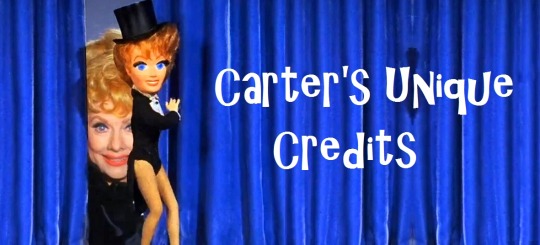
Directed by George Marshall ~ Written by Milt Josefsberg and Ray Singer
Synopsis
When Kim goes to a drive-in movie with her boyfriend Alan, Lucy and Harry spy on them dressed in hippie clothes to blend in.
Regular Cast
Lucille Ball (Lucy Carter), Gale Gordon (Harrison Otis Carter), Lucie Arnaz (Kim Carter), Desi Arnaz Jr. (Craig Carter)
Guest Cast
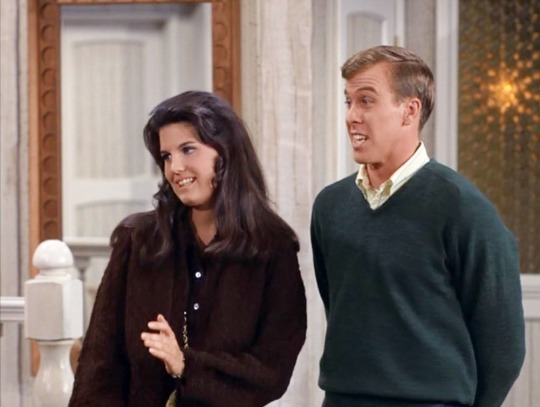
Robert L. Hughes (Alan Stevens) was mainly a theatre artist with only a dozen screen appearances, including playing the Colorado River Guide in “Lucy Runs the Rapids” (S2;E4). Hughes left show business in the 1980s to pursue a business career.
Interestingly, in his previous appearance as the Colorado River Guide, Kim flirted with him, which Lucy disapproved of. Alan's mother is in the social register and his father is a millionaire. He is 21 and taking post-graduate courses. Lucy still disapproves of him!

Larry J. Blake (Manager of the Drive-In) appeared as a Native American Medicine Man in “Lucy the Rain Goddess” (TLS S4;E15). He was an ex-vaudevillian making the second of his eight “Here’s Lucy” appearances.
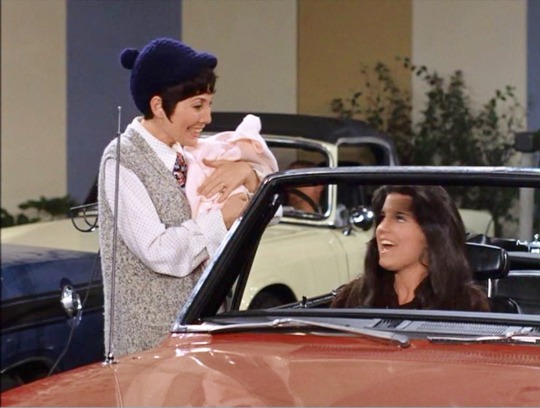
Jackie Joseph (Jackie Berry) is perhaps best known as Audrey in the 1960 (non-musical) horror/comedy film The Little Shop of Horrors. From 1960-76 Jackie Joseph was married to performer, Ken Berry, one of Lucille Ball's protege's who was shooting “Mayberry R.F.D.” on the Desilu Paramount lot and followed “Here's Lucy” on the CBS Monday night line-up. Joseph and Lucille Ball appeared together in the film A Guide for the Married Man (1967).
Jackie Joseph is using her married name for the character. Jackie Berry is a married friend of Kim's who has a newborn named Wendy. Her husband is in the service.

Orwin C. Harvey (Drive-In Patron with dog, uncredited) was an actor and stuntman who played one of the singing and dancing teamsters in “Lucy Helps Ken Berry” (TLS S6;E21). This is one of his six appearances on “Here’s Lucy.”
Harvey was featured on the same “Lucy Show” episode that also starred Jackie Joseph’s husband, Ken Berry.
Robert Buckingham (Drive-In Patron, uncredited) had been seen with Lucille Ball in Critic's Choice (1963). This is his third and last uncredited appearance on the series.
Other men and women (and one dog) at the drive-in go uncredited.

The final draft of this script was submitted on April 28, 1969.
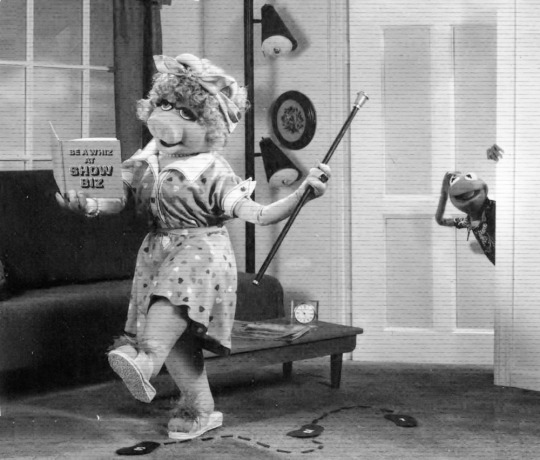
On the date this episode was originally aired (November 10, 1969) “Sesame Street” debuted on PBS, changing the landscape of children's television. In 1970, production memos for the show indicate that Lucille Ball and Gale Gordon were to be guest stars, with their segments taped at the Paramount stage where they were shooting “Here's Lucy.” The appearances, however, were postponed and never came to be. In 2007 “Sesame Street” mentioned “I Love Lucy,” although they were referring to Lucy the Lazy Lizard. During the reference, the background music was similar to the “I Love Lucy” theme. In the book Sesame Street Unpaved it is pointed out that Snuffy shares his astrological sign, Leo, with Lucille Ball.
"Vitameatavegemin is almost as hard to say as Snuffleupagus".

In the DVD introduction to the episode, Jackie Joseph reinforces that Lucille Ball was all business on the set, but a dear friend when not working.
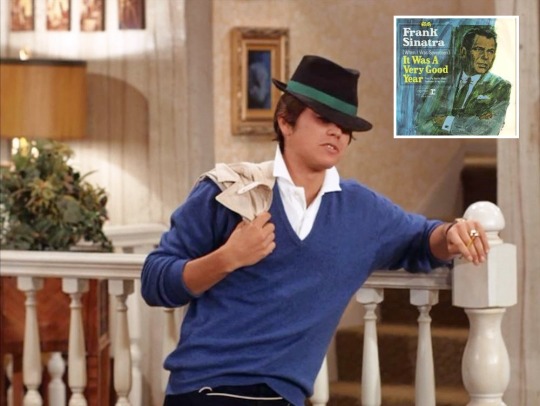
The episode opens with Craig alone in the living room singing along to a record. "It Was a Very Good Year" is a song Ervin Drake composed in 1961 for and originally recorded by Bob Shane with The Kingston Trio. It was subsequently made famous by Frank Sinatra and won him a Grammy Award in 1966. Craig imitates Sinatra's performance style, but Lucy jokingly says she thought he was imitating Lawrence Welk. Lucy admits that Sinatra was her idol when she was a bobby-soxer. Lawrence Welk will make an appearance as himself on a future “Here's Lucy” episode. Although Lucille Ball knew Sinatra socially, the two never acted together on screen.
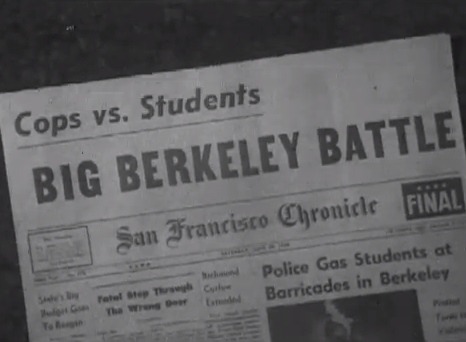
When Lucy hears that Kim's boyfriend Alan graduated from Berkeley, she is visibly upset. Craig jokes that Alan got two degrees and three arrests for picketing. During the 1960s the University of California Berkeley was the site of several riots and protest marches that received national attention.
When Lucy is concerned about Kim being too young for Alan, Craig reminds Lucy that she was 17 when she married his father. This is one of the few mentions of Lucy's late husband.

Kim and Alan are going to the drive-in to see a (fictional) Italian film titled La Notte Del Bacio Dolce, which translates to Sweet Night Kiss. Craig also goes on a date to another drive-in with his girlfriend Patty. This may be seen as a coy reference to Desi Jr.'s dating Patty Duke, although most sources agree that the two did not meet until 1970, a year after this episode was filmed.
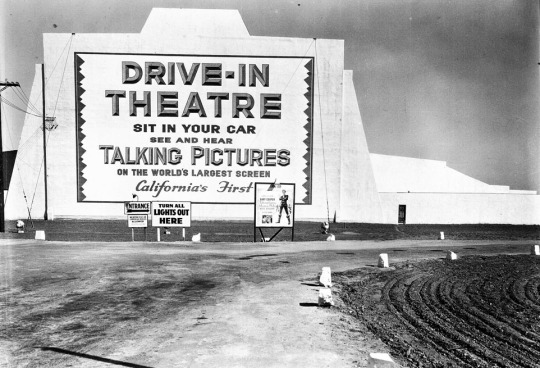
Lucy does a long comic take when she realizes Kim and Alan are going to a drive-in. In the 1950s and 60s drive-in movies were dubbed “passion pits” because they were a popular place for teenagers to be alone together for making out on a date. Although drive-in theatres were very popular in the 1960s there are hardly any remaining today. The first one opened in Camden, New Jersey in 1933. The fourth in the nation was in Los Angeles (above) in 1934. Although Lucy is a self-confessed movie fan, she acts as though she has never been to a drive-in before, not knowing how to activate the sound or where to hang the speaker.
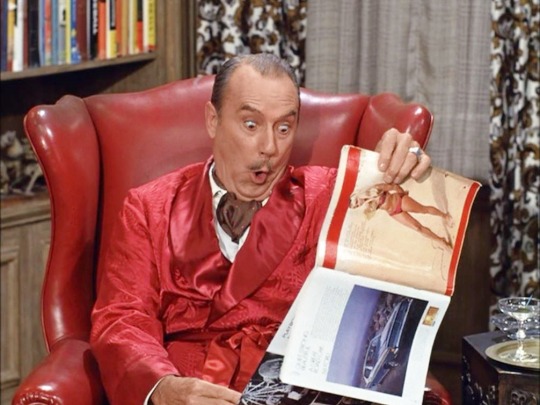
Meanwhile, bachelor Harry is home alone looking at the centerfold of a magazine that has a scantily clad woman on the cover! Although the magazine's name has been taped over, it is likely supposed to be Playboy magazine. In the image of Playboy’s founder, Hugh Hefner, Harry wears a red silk smoking jacket and is drinking a cocktail. While ogling the centerfold from every angle he sighs and sings “To dream the impossible dream.” “The Impossible Dream” was written by Joe Darion and Mitch Leigh for the 1964 Broadway musical Man of La Mancha. Harry also looked at a magazine with a centerfold in “Lucy's Birthday” (S1;E8).

This is an expensive shoot for “Here's Lucy” because of the many cars needed for the drive-in scene:
1969 Red Plymouth Barracuda convertible (Alan's car)
1965 Yellow Dodge Dart convertible (Lucy's car)
1969 Blue Plymouth Valiant (Younger necking couple's car)

1969 Blue Plymouth Barracuda (Older necking couple's car)
1969 Blue Simca 1204 [928] (Man with dog's car)
1964 Red Plymouth Valiant Signet
1969 Beige Simca 1118 [950]
1969 Yellow Triumph TR6

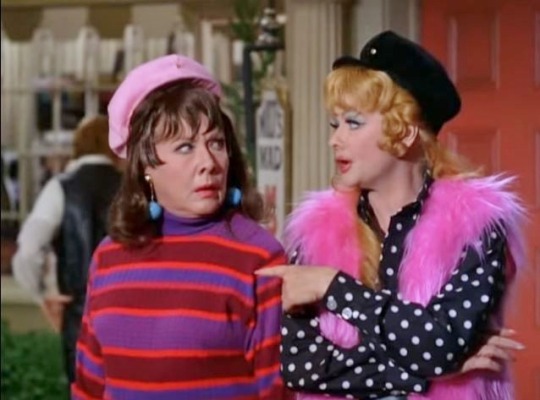
When “Viv Visits Lucy” (TLS S5;E15) they both dress as beatniks to spy on a friend's son who is hanging out with the hippies on the Sunset Strip.

Lucy and Harry's 1965 Dodge Dart is the same car used in “Lucy Helps Craig Get a Driver's License” (S1;E24)...

... except that the license plate was California WMO-526 and it is now UTM-541. Also, the dialogue infers that it is Harry's car, not Lucy's.
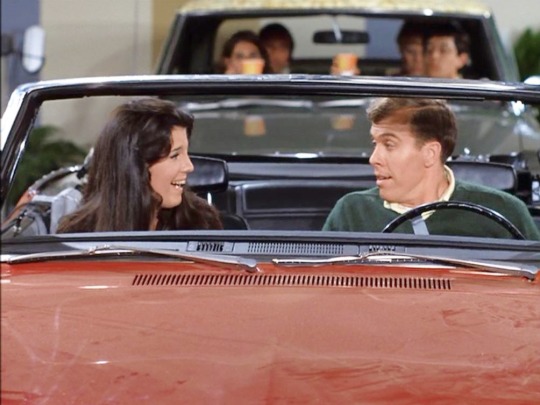
The hood of Alan's car has collected a great deal of dust. Apparently the vehicle was in studio storage for quite some time and not wiped down prior to shooting.

“Lucy at the Drive-In Movie” rates 4 Paper Hearts out of 5
Besides the crazy get-ups worn by Lucille and Gale , this episode is very funny, with a great twist ending.
#Here's Lucy#Drive-In Movie#Lucille Ball#Gale Gordon#Desi Arnaz Jr.#Lucie Arnaz#Jackie Joseph#Larry J. Blake#Robert L. Hughes#Robert Buckingham#Orwin C. Harvey#Sesame Street#USC Berkeley#It Was A Very Good Year#Frank Sinatra#Lawrence Welk#The Impossible Dream#Hugh Hefner#Playboy Magazine#Plymouth Barracuda#Dodge Dart#Plymouth Valiant#Simca#George Marshall#hippies#Milt Josefsberg#Ray Singer#1969#TV#CBS
3 notes
·
View notes
Text

Count von Count
PERFORMERS
Jerry Nelson 1972-2012
Matt Vogel 2013-present
DEBUT 1972
PATTERN Large Lavender Live Hand
Count von Count is a mysterious but friendly vampire-like Muppet on Sesame Street who is meant to parody Bela Lugosi's portrayal of Count Dracula. He first appeared on the show in the Season 4 premiere in 1972, counting blocks in a sketch with Bert and Ernie.
The Count has a compulsive love of counting (arithmomania, an affliction of legendary vampires); he will count anything and everything, regardless of size, amount, or how much annoyance he causes others around him. In one song he stated that he sometimes even counts himself. When he finishes counting, The Count laughs and announces his total (which sometimes appears on screen). This finale is usually accompanied by a crash of thunder and a flash of lightning, even on sunny days. (According to The Sesame Street Bedtime Storybook, the Count has a personal cloud that hovers over his head and provides the thunder and lightning.)
Many of the Count's songs, including "Counting Is Wonderful" and "The Batty Bat," are in the style of Roma music.
The Count lives in an old, cobweb-infested castle that he shares with many bats. Sometimes he counts them. Some of the pet bats are named, including Grisha, Misha, Sasha, and Tattiana. He also has a cat, Fatatita, and an octopus named Octavia. He also plays a large pipe organ, and in some illustrations he is seen playing the violin. In recent years, the Count has appeared on each episode to announce the Number of the Day, playing notes on his organ to count up to the featured number.
The Count's most recent girlfriend, Countess von Backwards, is known for counting backwards. He had previously been linked to Countess Dahling von Dahling and shared a brief romantic tryst with Lady Two. His brother and mother have appeared on the show, and he also has an Uncle Uno.
The Count's profile on Sesame Workshop's website does not use the word vampire but does suggest that he may be a distant relative of Count Dracula. However, the book Sesame Street Unpaved describes the Count as a "Numerical Vampire." In contrast, the 2001 Sesame Street Muppets Drawing Guide insists "The Count is not a vampire."
Nevertheless, the Count resembles Bela Lugosi's portrayal of Dracula in voice (speaking in an Eastern European accent and pronouncing his Vs as Ws), appearance, and sometimes mannerisms. For example, in early sketches, the Count waves his hands to exercise hypnotic power over other Muppets and holds his cape over the lower part of his face while moving. In addition, an early skit revealed that the Count shows no reflection in a mirror. Unlike vampires as traditionally depicted in legend and motion pictures, however, the Count often relaxes in the sunlight (as seen in "Counting Vacation" and "Coconut Counting Man," among others).
EARLY DAYS
The character was created by Sesame Street writer Norman Stiles. Performer Jerry Nelson recalled his immediate enthusiasm for the character in a 1999 interview:
“ Norman told me he was writing this piece with this new character who's called the Count... He's a vampire, but not a real vampire... He just has a jones for numbers. He's obsessed with counting things. So I went, "Oh, cool," and I went to Jim [Henson] and said, "You know, Norman's writing this new character called the Count." Jim said, "Let me hear it." So I went (in my Count voice), "Yes, I vould love to do it!" and Jim said, "Yes, you can do it." ”
The Count is now a friendly, non-threatening figure on the Street, but his early appearances in 1972 had a more sinister edge. He had hypnotic powers, and was able to stun other Muppets by waving his hands. After counting, he uttered a villainous laugh as lightning flashed in moody colors. He was often accompanied by creepy organ music. As the character matured, the sinister aspect of his personality was toned down, and his laugh became a throaty, Lugosi-style chuckle.
↑ hide
APPEARANCES
He made cameo appearances in The Muppet Movie (in the finale) and The Muppets Take Manhattan (in the wedding), and has also been featured in the Sesame Street movies Follow That Bird and The Adventures of Elmo in Grouchland. He also appeared in The Muppets: A Celebration of 30 Years and A Muppet Family Christmas.
The Count made a special appearance on episode 518 of The Muppet Show, emerging with his Sesame co-stars from the Three Bears' cave when Ali Baba shouts, "Open Sesame!"
On November 14, 1988, Count co-hosted The Today Show with Meryl Sheep.
On December 11, 2008, the Count was interviewed on More or Less, a BBC radio show about numbers.
↑ hide
NOTES
The Count's New York license plate number is "12345678910" in the movie Follow That Bird. However, in Count All the Way to Sesame Street, a book based on Follow that Bird, the Count's license plate number is simply "123."
The Count was a DJ for his own radio station on the album The Count's Countdown, and hosted a music video show in Count It Higher: Great Music Videos from Sesame Street.
In a Number of the Day segment for 0, The Count stated: "Oh hello, it is I, The Count. I'm called the Count because I love to count. Err, that, and I inherited my father's royal title." Despite this claim, the title of Count is one of nobility rather than royalty. (sesamestreet.org) Thus, The Count's claim to royalty might rest on his having inherited a lesser title of a royal ancestor.
According to the book Sesame Street Unpaved, after Jon Stone read the first script of a Count skit, he sent it back to the writer, Norman Stiles, with a note scribbled atop: "Good character, bad bit". That skit was never produced.
In Count it Higher: Great Music Videos from Sesame Street, The Count says that his favorite song is "Count it Higher". However, the book Sesame Street Unpaved states that his favorite songs are "Born to Add" and "Count on Me." Sesame Workshop's "Muppetbook" page also includes the song "99 Red Balloons."
The Muppetbook page also states the Count's favorite TV shows are 24 and 60 Minutes.
The Count's car is the Countmobile.
According to the 1998 book Sesame Street Unpaved, the Count is "written to represent an adult with the psychological age of someone who is 1,832,652 years old -- and still counting".
According to Sesame Street Stays Up Late!, the Count knows the exact time, and therefore knows when the new year arrives.
In Episode 4109, the Count states that he used to be a professor of counting from one to ten at the Institute of Technology at Moldavia.
In a few appearances (including The Street We Live On, episode 4109 and "Five By"), the Count sports a purple cape instead of his usual green one.
In Jerry Nelson's later years, Matt Vogel took over the puppetry of the Count while Nelson continued to provide the voice. This lasted until Nelson's death in 2012; Vogel debuted with his first vocal performance of the character in the 2013 video "Counting the "You"s in YouTube."
↑ hide
FILMOGRAPHY
See Count von Count Filmography
↑ hide
VIDEO GAME APPEARANCES
Sesame Street Countdown
Numbers
Get Set to Learn!
Search and Learn Adventures
Elmo's Number Journey
Count TV iPhone app
Elmo's Musical Monsterpiece
Kinect Sesame Street TV
↑ hide
BOOK APPEARANCES
Books starring Count von Count
The Sesame Street 1, 2, 3 Storybook (1973)
The Sesame Street ABC Storybook (1974)
The Sesame Street Book of Fairy Tales (1975)
Big Bird's Busy Book (1975)
See No Evil, Hear No Evil, Smell No Evil (1975)
Bert's Big Band Paint-with-Water Book (1976)
The Sesame Street Postcard Book (1976)
Cookie Monster and the Cookie Tree (1977)
The Sesame Street Block Party Coloring Book (1977)
Sesame Street Goes West (1977)
The Sesame Street Mystery Coloring Book (1977)
Who's Who on Sesame Street (1977)
The Sesame Street Bedtime Storybook (1978)
The Exciting Adventures of Super Grover (1978)
A Day on Sesame Street (1979)
Down on the Farm with Grover (1980)
Early Bird on Sesame Street (1980)
Look What I Found! (1980)
Molly Moves to Sesame Street (1980)
The Sesame Street Dictionary (1980)
The Sesame Street Pet Show (1980)
Special Delivery (1980)
The Tool Box Book (1980)
What Did You Bring? (1980)
Oscar's Rotten Birthday (1981)
Prairie Dawn's Upside-Down Poem (1981)
The Sesame Street Circus of Opposites (1981)
The Sesame Street Sun (1981)
What Do You Do? (1981)
City (1982)
A Day at School (1982)
74 notes
·
View notes
Photo

Big Bird’s Old-School crib from back in the good old days when we watched. Big Bird’s nest is the home of Big Bird on Sesame Street. Located to the right of 123 Sesame Street at 123½, with Oscar’s trash can between the two, Big Bird’s nest is set off by a collection of doors and paneling. Brick walls from surrounding buildings set off the area, giving Big Bird complete privacy, though no roof. One of the windows of Susan and Gordon’s apartment looks into the nest, and they have been sort-of surrogate parents to him over the years. His bed is a large-scale version of a real bird’s nest, made of sticks and twigs. The furnishings include crates, which serve as table space or benches for visitors, a bookshelf (containing such titles as March of Democracy, Preface to Philosophy, Principles of Chemistry, and Shattered Lamp), and a variety of diverse items. According to the book Sesame Street Unpaved, Big Bird’s nest contains: a bubble gum dispenser, a clock with no hands, a feather duster, a football helmet, a golf bag with one club, a hurricane lamp, a megaphone, a Roman bust (which has occasionally worn his red neck tie), a tricycle wheel, a watering can, an old record player, an umbrella, a mailbox, and a pair of snowshoes. Prominent decorations include an alphabet chart and Mr. Hooper’s Picture. Among other objects not listed in the book, he has a small wooden alphabet sign, a jack-and-balls game, and a picture of his cousin Abelardo. The opening of a 1974 episode reveals that he also has a pull-string lamp. When the set was given a complete makeover in 2002 following the hurricane in Season 32, Big Bird acquired some actual, colorful child-like furniture like a couple of multi-colored nightstands with drawers, a colorful bookshelf, and even a small wooden step-ladder to get into Big Bird’s nest. Most of the original belongings of Big Bird’s mentioned above have been removed with the exception of his snowshoes, and his mailbox (which is now repainted to no longer show his name on the side). For Season 46, Big Bird’s nest area saw another makeover; the construction doors have been removed, and the nest itself is wedged in between the branches or a large tree growing out of the cobblestone-covered ground. Small shelves and other of Big Bird’s personal items are nailed to the protruding branches. The nest used in Elmo in Grouchland was built by Geoffrey Cormier of the movie’s art department. The item was put on eBay, but didn’t sell, so in 2005, it was placed for sale on his website. That nest had thicker twisted branches than the contemporary television version. TRIVIA “Big Bird’s Nest” appears as a property on the Monopoly: Sesame Street Edition game board, in place of Pennsylvania Avenue.
12 notes
·
View notes
Note
I was watching a sesame street documentary and they showed Kermit and Rowlf planning a name for the kids show. Kermit thought of sesame street as the name becuase it soul's welcoming and rowlf told Kermit that he is a genious for coming of Wight that name and KISSED Kermit on either the lips or cheeks! You can't see where exactly since he covered Kermit as he went in front for a kiss. The documentary is "sesame street unpaved"
((continued from my last ask)) Nope it’s the lips definitely
I know exactly what you’re talking about!! I saw it back when I found the sesame street pitch reel on youtube and I just…. like…. Wow. Those two had quite a subtexted history didn’t they??
There’s the kissing on the lips and in their very first appearance together, Kermit kisses Rowlf on the cheek. And right before that, Kermit was visibly swooning when Rowlf was going on about how handsome muppets are, assuming that he was specifically talking about him.
I know they were joking when someone messaged me about Jim lowkey shipping them but like… I wouldn’t be surprised if someone digs up some old notes of his that say they’re gay for a each other or smt. Like at all. Because those two had a lot of onscreen tension back when Jim was alive… Actually, scratch that, they STILL do.
Shit’s wild man.
6 notes
·
View notes
Video
youtube
Sesame Street Unpaved - Mr. Hooper's Death (1999) - One of the realest moments from one of the realest TV shows ever made.
0 notes
Video
(via (2) Sesame Street Unpaved - Mr. Hooper's Death (1999) - YouTube)
0 notes